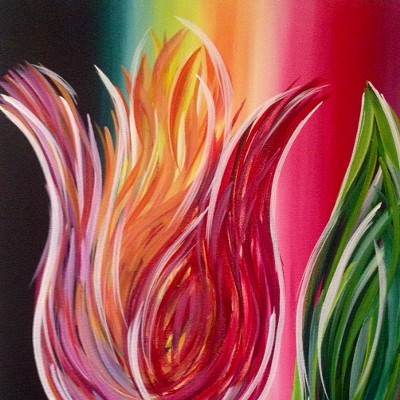Her 18 works at The Drawing Studio are officially drawings in colored ink, but they look like nothing so much as the most fluid of paintings, wildly rendered in the wildest of hues.
Blood red, sun yellow, jungle green and nightmare black explode across her sheets of drawing paper, which somehow seem larger than their 18 by 24 inches. Spattered, layered, slashed and sometimes even finger-painted, her brushes and fingers going every which way, these works are the freest yet from this Tucson painter.
Better known for her more commercial paintings on acrylic, which she readily sells at Wilde Meyer in the Foothills, Rossa on this go-round is working improvisationally. She writes in an artist's statement, "I could do 500 of these without thinking or waiting for inspiration. They are completed in one linear process; then I begin another one."
So engaging is her technique that at first, you almost ignore the works' searing subject matter. Though at times almost abstracted, they're full of the children, violins, cats, dogs, plants and flowers that fill her regular, more cheerful paintings. Filling the domestic interiors of these works in a kaleidoscope of colors; they make for pictures that look almost like gardens gone wild indoors. That is, until the figures explode.
Because there are also male monsters aplenty in these pictures, and headless women and flying hands cut off from any body. A male alligator fiend appears in green and a hellish wolf-man in red, not to mention the woman whose head and limbs have been cut off, and the woman whose face has been obliterated by a slash of black ink. The kids and cats and other innocent things are caught in the maelstrom whirling around these terrifying and terrified adults.
The Other Side, as the series is called, is a nightmare vision of domesticity, not only of a house divided, but a house detonated and destroyed.
A couple of the drawings conjure up free-form abstract space, but most of them picture a large room, whose only exit is a dark, windowless corridor. The domestic architecture yields up a palpable sense of entrapment.
"The Other Side III" is typical. A small child with spindly red hands plays a grand piano in a room whose teal walls open up on a doorway where a cat, incongruously, stands playing a violin. Their music--perhaps--protects these two, cat and kid, from the dreadful drama at hand.
In the center of the room, the alligator monster, its penis creepily visible, a plant upon its head, embraces a horrified woman who seems to have no means of escape. A boy lies naked on the floor at their feet; it's unclear whether he's dead or alive. A small girl clutches another cat, for comfort, one supposes. Plenty of other cats and even birds fly around the room, which reverberates in sickly yellow and belligerent blue.
In "The Other Side I" the figures grow larger, taking up more space and dominating the house of horrors. The room has turned a violent orange and black. A large female figure in orange, her blackened face seeming to erupt off her skull, is front and center, her arms waving wildly, a small child clinging to her. Other children look on, while a young girl studiously ignores the scene, concentrating instead on playing her violin. The desperate mother may well think that she's on the verge of escape. But a tall, naked figure blocks the doorway, and a baying black hound tails the fleeing woman and child.
This collection of creatures may have hit bottom in "The Other Side XIII." The black doorway is dissolving into hell, and a flying monster seems to be devouring a child painted yellow and orange. Yet despite a giant red rooster on the attack and a giant blue cat, a little girl in a dress continues to play her violin. An angel's wing sprouts from her back.
Darkly shaded though its notes are, music pervades these pictures. The power of music--and the power of art-making--helps counter-balance their catalogue of evils. Rossa says that her work is inspired by Brahms, by Rachmaninov, by Chopin, by Bach and by jazz, and this jazzy improvisational sensibility informs the fluid brush strokes of color and the free-flowing lines.
Even more importantly, perhaps, in almost every scene of horror, the little violinist plays on.














